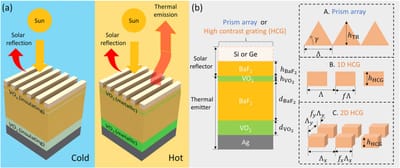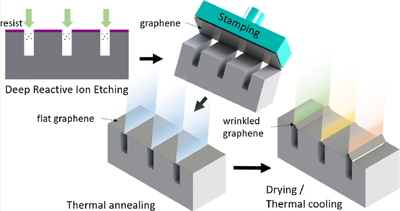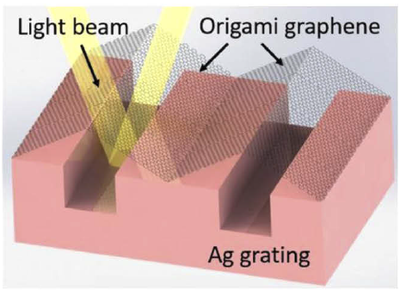Welcome to Ken Araki's World
Explore the life and achievements of Ken Araki
3 years in process engineering, thin film coating fabrication (Sputtering, Evaporation, PECVD, ALD, RTP, Furnace)
3+ years in laboratory equipment, thin film characterization (FTIR, Ellipsometry, Profilometer, Four-Point Probe Station)
6+ years in optical nanomaterials engineering (TMM, RCWA, Lumerical FDTD) in multilayers, metasurface
3+ years in machine learning and deep learning (Bayesian Optimization, Neural Network) Proficient in programming (MATLAB, Python, C++)
Problem solver and application testing: Designed and fabricated vanadium dioxide-based metafilm that absorbs solar radiation during daytime and radiative heat during nighttime, resulting in continuous power generation by having the metafilm on thermoelectric generator.
Applied Devices: Power generation, Solar absorber, Radiative cooler, Thermal blanket
Skills
Thermal engineering (FEA)
Finite Element Analysis with SOLIDWORKS
Heat transfer analysis
Thermal conduction Thermal convection Thermal radiation
Data acquisition and analysis
Digital multimeter (DMM6500) Source meter Kickstart
Process engineering
Sputtering E-Beam Evaporation PECVD ALD Rapid Thermal Process (RTP) Furnace
Optical engineering
Transfer matrix method (TMM) Rigorous coupled-wave analysis (RCWA) Finite difference time domain (FDTD)
Thermal vaccum testing
Optimization, Machine Learning, Deep Learning
Genetic Algorithm (GA) Bayesian Optimization (BO) Neural Network (NN)
Temperature sensors
Infrared camera (FLIR) Thermistor Thermocouple RTD
Characterization
FTIR Tunable light source (TLS) Integrating sphere Four point probes (FPP) IV curve (source meter) Profilometer
Programming
MATLAB Python C++
Problem solving
Ex: Resolved thermal expansion mismatch between the substrate by introducing thin layer of material with smaller thermal expansion coefficient
Teamwork, Collaboration
Ex: Provided optical characterizations to team members for their samples
Experience
Arizona State University, Postdoctoral Researcher (Mentor: Dr. Liping Wang)
Jan 2023 - Present
Spearheaded continuous power generation project in vacuum chamber, using innovative self-adaptive VO2 coating with thermoelectric generator (TEG) and implementing IV curve analysis with Keithley source meter
Designed and fabricated tunable vanadium dioxide thin films which behave as solar absorber during daytime and radiative cooler during nighttime, achieving 170K temperature rise during daytime and 17K drop during nighttime
Implemented temperature stages made with thermoelectric cooler and PID control, improving temperature stability and control within 1K for FTIR, Tunable Light Source (TLS) with Integrating Sphere, and Four-Point Probes (FPP), broadening the operating temperature range down to -20°C. • Enhanced accuracy of electrical resistivity characterization by developing FPP station and validating its measurement for temperature-dependent electrical resistivity characterization of +10 thin film samples.
Investigated growth of VO2 thin films and multilayers using various advanced deposition technologies including sputtering, furnace oxidation and rapid thermal annealing (RTP), resulting in an enhancement in infrared transmittance contrast from 23% to 46%
University of North Texas, Postdoctoral Researcher (Mentor: Dr. Richard Zhang)
Dec 2023 - Aug 2024
Optimized resonant gratings (high contrast grating and guided mode resonator) geometric parameters using Genetic Algorithm, Bayesian optimization, and neural network, minimizing emissivity down to 0.02.
University of North Texas, Teaching Assistant
Aug. 2021 – Dec 2022
Delivered two recitations per week and graded homework, exams, and quizzes for undergraduate courses (thermodynamics (Fall 2021), heat transfer (Spring 2022, Fall 2022)
University of North Texas, Graduate Research (Mentor: Dr. Richard Zhang)
Aug 2019 - Dec 2022
Delivered comprehensive optical characterization using Variable Angle Spectroscopic Ellipsometry (VASE), and led the project in collaboration with Department of Chemistry
Proposed thermally and electronically tunable plasmonic grating and graphene covered plasmonic grating by using RCWA for tunable optical radiative properties
Improved performance of vanadium dioxide based self-adaptive radiative cooler using RCWA, FDTD, and Bayesian optimization, enhancing emissivity contrast up to 0.73
Niigata University, Undergraduate research (Mentor: Dr. Atsushi Sakurai)
Apr 2018 - Mar 2019
Optimized radiative cooling device through optimization algorithms (Genetic Algorithm) by using transfer matrix method (TMM) and rigorous coupled-wave analysis (RCWA) coded with MATLAB and Python
National Institute of Technology Gunma College, High school research (Mentor: Dr. Masashi Kurose)
Apr 2016 - Mar 2017
Conducted thermal analysis on the effect of grinding speed on work hardening of austenitic stainless steel by utilizing SOLIDWORKS simulation (FEA) to optimize process parameters which prevent phase transition from austenitic to martensite
Research

(7) Maximizing Infrared Transmission Contrast upon Phase Transition of Thermally Grown Vanadium Dioxide Thin Films by Rapid Thermal Processing
Pristine vanadium dioxide (VO2), an insulator-to-metal transition (IMT) material, is grown via furnace oxidation followed by rapid thermal annealing with forming gas (5% H2/95% N2) which reduces surface over-oxides such as V2O5 formed during the oxidation. The evolutional IMT behaviors of the thermochromic film and vanadium oxide states over different reduction times are systematically studied with temperature-dependent infrared spectrometry, electrical resistivity, and X-ray diffraction measurements. After optimally reducing surface over-oxides to VO2, infrared transmission contrast upon phase transition is enhanced to 46% (at 9 μm wavelength) compared to 23% from full oxidation without any reduction. Moreover, the pristine VO2 thin film obtained from thermal oxidation and optimal reduction processes exhibits sharp phase transition and narrow thermal hysteresis within 2–4 °C in both infrared transmission and electrical resistivity, which are comparable to the best quality VO2 prepared by other sophisticated fabrication techniques. The thermally grown method presented here would facilitate the scalable fabrication of high-quality VO2 thin films and tunable radiative coatings for high-performance thermal control applications.
Read More
(6) Resonant-mode metasurface thermal super mirror by deep learning-assisted optimization algorithmsRelease
A “super-mirror” having ultrahigh infrared reflectance is achieved by an optimized photonic contrast grating metasurface. Finding ways to achieve this exceptional performance can be enabled by implementing global optimization and machine learning elements, such as Bayesian optimization and genetic algorithm. Here, we acquired an optimized grating design made of high-index germanium, which excites resonances that result in ultralow emittance at certain wavelengths. Our optimizations assisted in the discovery of hybridized coupling of Fabry-Pérot modes and guided modes in a monolithic microscale multilayered coating. We demonstrate constraints in the given geometric variable ranges improves the overall performance of algorithms. We also show the enhanced performance of a deep learning Feedforward Neural Network, which is implemented as the inverse design using the network trained with dataset obtained from Bayesian optimization and Genetic Algorithm approaches. The performance of the Feedforward Neural Network-assisted design produced normal emissivity difference by only +3.5 %, with lower sensitivity to grating dimensional parameter variations. The improvement is achieved by predicting and better understanding of the optical physics of resonant gratings. The proposed few-layer grating coating can be applied to space components, enclosures, and vessels to suppress thermal radiative heat loss.
Read More
(5) Infrared radiative switching with thermally and electrically tunable transition metal oxides-based plasmonic grating
Plasmonic and phase transition has been blended to gain the infrared radiative switching which is tunable with temperature or voltage supply. This is applied via vanadium dioxide, tungsten trioxide, and molybdenum trioxide as transition metal oxides (TMO). The metallic phase at high temperature or colored state contributes in magnetic polariton (MP) excitation, producing broad absorptance. The TMO-based sub-layer is integrated underneath the grating fully supporting MP resonance. In contrast, this underlayer leads to producing the narrowband absorptance originated from concept of zero contrast grating (ZCG). The zero gradient in refractive index at the output plane of the grating cause transmission of light in broad wavelength range. With introduction of reflective silver underlayer, those transmitted through the grating are reflected back. However, there exists the near-zero narrowband transmission peaks in ZCG. This undergoes transformation to narrowband absorptance. In addition, another absorptance peak can be induced due to phonon modes at insulating phase. The MP resonance at metallic phase is characterized with inductor-capacitor (LC) circuit and the narrowband absorptance peaks are characterized with phase shift from the Fabry–Perot round trip (FP-RT) eigenequation from high contrast grating (HCG). The work expands the usage of transition metal oxides in infrared region with larger contrast.
Read More
(4) Simultaneous solar rejection and infrared emission switching using an integrated dielectrics-on-VO2 metasurface
Passive infrared emittance switching can be achieved with a metal-to-insulating phase transition material vanadium dioxide (VO2), but its non-transitioning bandgap results in high absorptance in the visible wavelength range. To achieve a half-order reduction of absorptance in the visible to near-infrared region, we design integrated dielectric photonic metasurface structures on monolithic VO2 coatings. This combination of nano/micro-patterned dielectric diffractive and resonant gratings with a multilayer VO2 structure preserves the terrestrial thermal wavelength emission switching capabilities. We demonstrate a periodic microscale diffractive prism array, comparing the reflectance provided by either infrared-transparent germanium (Ge) or silicon (Si). Despite the advantage of total internal reflection in the broad near-infrared region, some bandgap absorption limits the performance in the visible wavelengths. A better theoretical means to reflect broadband light via waveguide-like Fabry–Pérot resonance are near-wavelength 1D and 2D High Contrast Grating (HCG) high-index metasurface structures surrounded by a low-index host medium. This HCG metasurface allows broadband high-quality reflection within the dual-mode (or tri-mode) region from 1.0 to 2.2 µm wavelengths for HCG with a refractive index of 4.0, which corresponds to Ge. This study investigates the advantages and disadvantages along with the thermal performance of these metasurface augments aimed to enable thermally switchable passive radiative cooling—thermal emission exceeding solar absorption—of solar cells, terrestrial buildings, and energy storage devices.
Read More
(3) An optimized self-adaptive thermal radiation turn-down coating with vanadium dioxide nanowire array
Insulator-to-metal temperature phase transition Vanadium Dioxide (VO2) can enable radiative property switching in the mid- to far-infrared wavelengths. With computational optimization of grating arrangement and layer thickness parameters, we identify a monolithic high-performance turn-down thermal emittance coating of no more than 2 μm thick, consisting of a VO2 sub-wavelength nanowire grating array on an index-matched Fabry-Perot dielectric thin film on an additional absorbing VO2 sublayer. The working principles of this optimized VO2 structure are its gradient refractive index allowing high through-coating transmittance in the cold state, and its near-unity emissivity from semi-metal-insulator-metal plasmonic coupling in the hot state. This anisotropic patterned structure also considers performance over polarized incident light. A survey of other Fabry-Perot cavity materials with refractive index matching points to higher turn-down performances given an optimal VO2 nanowire volume filling ratio. With 24-hour solar and environmental analysis in comparison to other VO2 metasurfaces and multilayers, this coating enables responsive passive radiative cooling at high temperatures exceeding transition. This nano/micro-patterned coating could potentially impact self-cooling of the solar cells, batteries, and electrical devices where risk presents at high temperatures.
Read More
(2) Mechano-optical resonant emission by edge angle modulation of wrinkled graphene on plasmonic metal gratings
Graphene coated on top of photonic-plasmonic metasurfaces can produce resonant radiative emission in the mid-infrared region. Narrowband emission peaks are observed through folding graphene into “origami” ridges over metal grating grooves, creating a complementary cavity mode above the trench. This geometrically tuned phenomenon of graphene surface plasmon excitation along the folded sheet enhances the emission when added to magnetic polariton (MP) resonance induced within the plasmonic grating groove. Our analytical models describe how this graphene surface plasmon polariton (SPPG) is a function of folded graphene geometric parameters, and most importantly, the graphene edge angle that distends from the grating surface. The frequency-dependent phase shift of SPPG is fitted to grating parameters, and a modified inductor-capacitor circuit model was developed for predicting MP resonance mode with graphene influence. It was found that the edge angle of wrinkled graphene blue-shifts the groove MP resonance and SPPG resonant emission peak in both wrinkled graphene alone and with the grating substrate. The understanding of geometrically modulated graphene adhered on plasmonic gratings impacts the design and capability of narrowband cavity emitters and contributes toward the development of mechanical-optical environmental sensors.
Read More
(1) Plasmon-resonance emission tailoring of “origami” graphene-covered photonic gratings
Due to the negative coefficient of thermal expansion of graphene, temperature changes of graphene-coated photonic surfaces could induce resonant mode shifts in diffractive optical absorptance and emission. This study focuses on the modification of optical properties through folding, or “origami,” of graphene covering a plasmonic metal channel grating. This work is especially critical to understanding tailored deep plasmon emission from geometrically-modulated conducting sheets such as graphene. Conformational changes in graphene on gratings are found to tailor cavity resonance emission and plasmonic oscillations such as magnetic polaritons (MPs) and surface plasmon polaritons (SPPs), respectively. Up to 46% reduction in radiative absorptance was observed through retarded MP. Excited SPP modes can increase narrowband absorptance of 0.5 through folding of graphene. Tailoring of optical absorptance can be used for applications such as photodetectors and thermal emitters.
Read MorePublications
Publications (Google Scholar)
(9) V.K. Rajan, K. Araki and L. Wang, "Thermal Radiative Properties of Tungsten-Doped Vanadium Dioxide Thin Films Fabricated in an Extremely Low-Oxygen Furnace Environment." International Journal of Thermophysics, 47 (1), 9 (2026) link.
(8) K. Araki, V.K. Rajan and L. Wang, "Maximizing Infrared Transmission Contrast upon Phase Transition of Thermally Grown Vanadium Dioxide Thin Films by Rapid Thermal Processing." ACS Applied Electronic Materials, 7 (21), 9754-9764 (2025) link.
(7) K. Araki and R.Z. Zhang, "Resonant-Mode Metasurface Thermal Super Mirror by Deep Learning-Assisted Optimization Algorithms." Journal of Quantitative Spectroscopy and Radiative Transfer, 109195 (2024) link.
(6) K. Araki and R.Z. Zhang, "Infrared radiative switching with thermally and electrically tunable transition metal oxides-based plasmonic grating." Scientific Reports, 13 (2023) link.
(5) R.Z. Zhang and K. Araki, “Ultralow Emittance Thermal Radiation Barrier Achieved by a High-Contrast Grating Coating.” AIAA Journal of Thermophysics and Heat Transfer, 1-13 (2022) link.
(4) K. Araki and R.Z. Zhang, “Simultaneous solar rejection and infrared emission switching using an integrated dielectrics-on-VO2 metasurface.” AIP Advances 12 (5), 055205 (2022) link.
(3) K. Araki and R.Z. Zhang, “An optimized self-adaptive thermal radiative turn-down coating with vanadium dioxide nanowire array.” International Journal of Heat and Mass Transfer 191, 122835 (2022) link.
(2) K. Araki and R.Z. Zhang, “Mechano-Optical Resonant Emission by Edge Angle Modulation of Wrinkled Graphene on Plasmonic Metal Gratings.” ACS Applied Nano Materials 4 (8), 8399-8407 (2021) link.
(1) K. Araki and R.Z. Zhang, “Plasmon-resonance emission tailoring of “origami” graphene covered photonic grating.” Optics Express 28 (15), 22791-22802 (2020) link.
List of Journals
- International Journal of Heat and Mass Transfer (IF5.8)
- ACS Applied Nano Materials (IF5.5)
- ACS Applied Electronic Materials (IF4.7)
- Scientific Reports (IF3.9)
- Optics Express (IF3.3)
- International Journal of Thermophysics (IF2.9)
- Journal of Quantitative Spectroscopy and Radiative Transfer (IF1.9)
- AIAA Journal of Thermophysics and Heat Transfer (IF1.7)
- AIP Advances (IF1.4)
Conference Presentation
(8) K. Araki and L.P. Wang, "All-Day Thermochromic Solid-State Power Generation With Self-Switchable Thermochromic Coating." (IMECE 2024), Portland, OR, Nov. 17-21, 2024 link.
(7) K. Araki and R.Z. Zhang, "Resonant-Mode Metasurface Thermal Super Mirror Assisted by Machine Learning." (Nanorad 2024), Sapporo, Hokkaido, Japan, Jul. 17-19, 2024 link.
(6) K. Araki and R.Z. Zhang, "Broadband Thermal Management of Infrared Zero Contrast Grating." (MRS Fall Meeting 2023), Boston, USA, Nov. 27 - Dec. 01, 2023 link.
(5) K. Araki, F. Anwar, S. Alhowity, O. Omolere, L. Wang, J. A. Kelber and R. Z. Zhang, "Epitaxial growth of vanadium dioxide for thermochromic coatings." (Asian Thermophysical Properties Conference (ATPC 2022), Virtual Conference, Sendai Japan), Sept 26 - 30, 2022 link.
(4) K. Araki and R.Z. Zhang, “Mid-infrared transparent solar reflector using high-index material for thermochromic and thermo-radiative cooling metasurfaces.” (Metamaterials, Photonic Crystals and Plasmonics Conference | META 2022), July 19-22, 2022 link.
(3) K. Araki and R.Z. Zhang, “Self-Thermal Regulating VO2-Fabry-Perot Cavity Coating for Passive Radiative Cooling Device.” ASME Summer Heat Transfer Conference (SHTC), Philadelphia, USA, July 11, 2022 link.
(2) K. Araki and R.Z. Zhang, “Tailoring optical properties of “origami” graphene covered photonic grating.” (IEEE Photonics 2021 Virtual Conference), October 19, 2021 link.
(1) K. Araki and M. Kurose, “The Effect of Grinding Speed on Work Hardening of Austenitic Stainless Steel.” 56th Graduating Research Conference, Japan Society of Mechanical Engineers, Tokyo, Japan, March 16, 2017 link.
Chapters
(1) R.Z. Zhang and K. Araki, Thermal High-Contrast Metamaterials, Thermal Plasmonics and Metamaterials for a Low-Carbon Society (2024) link.
Teaching Experience & Training
- Graduate Student Teaching Excellence Program (GSTEP, Fall 2022)
- MEEN 5315 Nanoscale energy Transport (Chapter 8: Fundamentals of Thermal Radiation, Chapter 9: Radiative Properties of Nanomaterials)
- Undergraduate Course Teaching Experience (Spring 2022)
- MEEN 3210 Heat Transfer (Chapter 12: Thermal Radiation)
Education
University of North Texas, Denton, TX
Aug. 2019 - Dec. 2022
Ph.D. in Mechanical Engineering, GPA: 4.00/4.00
Niigata University, Niigata Japan
Apr. 2017 - Mar. 2019
B.S. in Mechanical Engineering, Overall GPA: 3.22/4.00, Major 3.28/4.00
National Institute of Technology Gunma College, Gunma Japan
(Japanese combined five-year high school-university)
Apr. 2012 - Mar. 2017
Mechanical Engineering (Associate), Overall GPA: 3.65/4.00
Membership
awards & scholarship
- Toulouse Graduate School Travel Grant: $500, Summer 2022
- College of Engineering Travel Grant: $500, Summer 2022
- Best Presentation Award, IMECE 2024, Portland, OR
Personal Interests
- Listening to music (pop, rock, alternative, indie rock)
- Watching movies (action, sci-fi, adventure, mystery, suspense)
- Walking
- Playing and watching tennis
- Playing table tennis
- Watching baseball (Seattle Mariners, Los Angeles Dodgers, San Diego Padres, Chicago Cubs, Boston Red Sox, New York Mets)
Living Experience
- San Diego, California
- Ohtawara, Tochigi, Japan
- Vancouver, Washington
- Takasaki, Gunma, Japan
- Niigata, Niigata, Japan
- Denton, Texas
- Tempe, Arizona
Travel Experience
- Japan: Hokkaido, Fukushima, Ibaraki, Saitama, Tokyo, Yokohama, Kawasaki, Tsurumi, Kamakura, Kyoto, Osaka, Nara, Shiga, Sendai, Kanazawa, Toyama, Fukui
- USA: Seattle, Walla Walla, Portland, Beaverton, Dallas, San Jose, Oakland, San Francisco, Los Angeles, San Diego, Urbana-Champaign, Chicago, Boston, Philadelphia
- Europe: Spain
Contact
- 551 E Tyler Mall, Tempe, AZ 85281